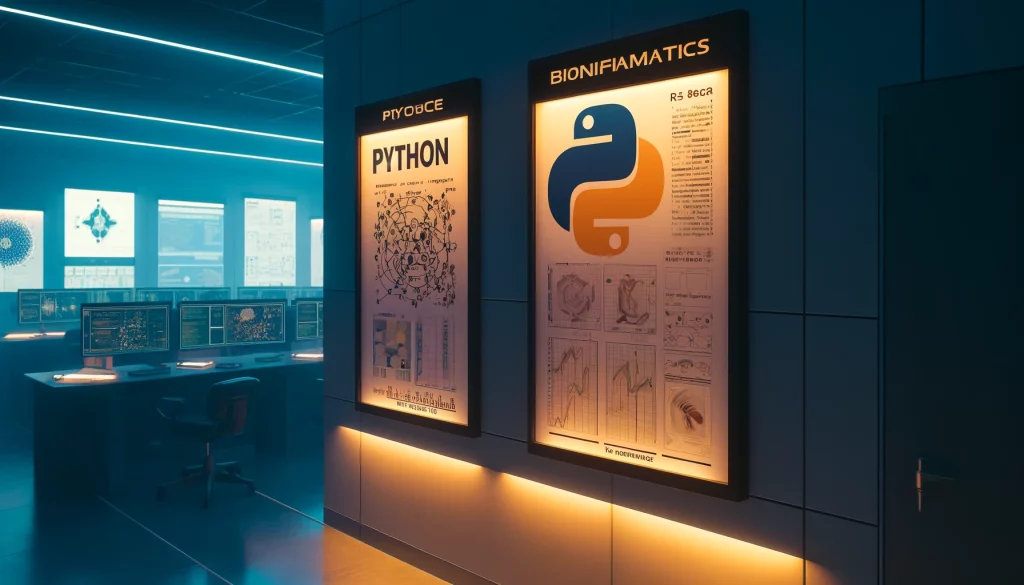Sequence alignment algorithms are essential tools that enable scientists to compare biological sequences such as DNA, RNA, and proteins. These algorithms help identify regions of similarity that may indicate functional, structural, or evolutionary relationships between the sequences. Below, we explore 11 key categories of alignment algorithms, each with unique features and applications in the field of bioinformatics. This classification is based on my studies and you might see some different classifications in other references. In this Article first, you will read a brief about each category, then the main feature of each category, and then a list of existing algorithms for alignment in that group. This style can shape the minds of readers better around different alignment algorithms. I should mention that some algorithms may be compatible with different groups. Also you should consider that some algorithms have a software named exactly like the algorithm name.
Global, Local, and Semi-Global Alignments
Sequence alignment algorithms are often categorized based on the extent of sequence alignment. Global alignment algorithms, like the Needleman-Wunsch algorithm, align entire sequences from end to end, optimizing the overall match. Local alignment algorithms, such as the Smith-Waterman algorithm, focus on finding the highest-scoring subsequences within larger sequences, which is useful for identifying conserved motifs or domains. Semi-global alignment strikes a balance by allowing partial overlaps without penalizing unaligned ends, making it ideal for sequences with varying lengths or when terminal regions are less conserved.
Main Feature: Determines whether the alignment spans the full sequence, specific subsequences, or partially overlaps.
Algorithms:
- Global Alignment: Aligns entire sequences from end to end.
- Fundamental Algorithms:
- Needleman-Wunsch Algorithm
- Myers-Miller Algorithm (space-efficient variant)
- Software Tools:
- Implementations in various bioinformatics software.
- Fundamental Algorithms:
- Local Alignment: Focuses on the most similar subsequences.
- Fundamental Algorithms:
- Smith-Waterman Algorithm
- Waterman-Eggert Algorithm (finds multiple local alignments)
- Software Tools:
- SSEARCH (full Smith-Waterman implementation)
- Fundamental Algorithms:
- Semi-Global Alignment: Allows partial overlap without penalizing unaligned ends.
- Fundamental Algorithms:
- Modified Needleman-Wunsch Algorithm for semi-global alignment
- Software Tools:
- Available in some sequence alignment packages.
- Fundamental Algorithms:
Pairwise vs. Multiple Sequence Alignments
Pairwise sequence alignment involves comparing two sequences to find the best-matching regions, essential for tasks like identifying mutations or studying protein interactions. In contrast, multiple sequence alignment (MSA) extends this comparison to three or more sequences simultaneously. MSA algorithms, such as CLUSTAL Omega and MUSCLE, are crucial for identifying conserved sequences across species, constructing phylogenetic trees, and predicting secondary or tertiary structures in proteins and nucleic acids.
Main Feature: Pairwise sequence alignment algorithms compare two sequences, while MSA aligns three or more, identifying conserved regions across sequences.
Algorithms and Tools:
- Pairwise Sequence Alignment:
- Fundamental Algorithms:
- Needleman-Wunsch (Global Alignment)
- Smith-Waterman (Local Alignment)
- Heuristic Algorithms (Faster, suitable for large databases):
- BLAST (Basic Local Alignment Search Tool)
- BLAT (BLAST-like Alignment Tool)
- FASTA
- SWIFT (Smith-Waterman with Interpolated Fast Transforms)
- PatternHunter
- LAST (Large-scale Alignment Search Tool)
- DIAMOND (Fast protein aligner)
- USEARCH/VSEARCH (Ultra-fast sequence searching)
- MMseqs2 (Many-against-Many sequence searching)
- Fundamental Algorithms:
- Multiple Sequence Alignment (MSA):
- Progressive Alignment Methods:
- CLUSTAL Omega
- MUSCLE (Multiple Sequence Comparison by Log-Expectation)
- Kalign
- Iterative Alignment Methods:
- MAFFT (Multiple Alignment using Fast Fourier Transform)
- PRANK
- DIALIGN
- PASTA (Practical Alignment using SATé and Transitivity)
- Consistency-Based Methods:
- T-Coffee (Tree-based Consistency Objective Function For alignment Evaluation)
- ProbCons
- M-Coffee (Meta-aligner)
- Probalign
- Specialized Tools:
- MAUVE (Aligns multiple genomes with rearrangements)
- Progressive Alignment Methods:
Exact vs. Heuristic vs. Probabilistic Algorithms
The choice between exact, heuristic, and probabilistic sequence alignment algorithms depends on the balance between computational efficiency and accuracy. Exact algorithms guarantee an optimal alignment by exhaustively exploring all possible alignments, which can be computationally intensive for long sequences. Heuristic algorithms like BLAST and FASTA offer faster results by approximating the best alignment, suitable for large databases where speed is critical. Probabilistic algorithms incorporate statistical models to handle sequence variability and uncertainty, making them adept at detecting distant evolutionary relationships and modeling complex biological processes.
Main Feature: Exact algorithms yield optimal solutions, heuristic algorithms prioritize speed, and probabilistic algorithms use statistical models to account for variability.
Algorithms and Tools:
- Exact Algorithms: Provide precise alignment results.
- Needleman-Wunsch
- Smith-Waterman
- SSEARCH
- Heuristic Algorithms: Faster with acceptable trade-offs in precision.
- BLAST
- FASTA
- PatternHunter
- DIAMOND
- USEARCH/VSEARCH
- MMseqs2
- Probabilistic Algorithms: Useful for detecting homology under high variability.
- Hidden Markov Models (HMMs):
- HMMER
- SAM (Sequence Alignment and Modeling)
- Covariance Models:
- Infernal (INFERence of RNA Alignment)
- Bayesian Methods:
- BAli-Phy (Jointly estimates alignments and phylogenetic trees)
- Hidden Markov Models (HMMs):
Sequence-Based vs. Structural Alignments
While sequence-based alignments compare the linear sequence of nucleotides or amino acids, structural alignments consider the three-dimensional conformation of molecules, particularly proteins. Structural alignment algorithms, such as DALI and TM-align, are invaluable when sequences have low similarity but share similar shapes or functions. By incorporating spatial information, these algorithms can uncover functional similarities that sequence alignments alone might miss, providing deeper insights into protein folding, function, and evolution.
Main Feature: Sequence-based alignment uses sequence data alone, while structural alignment incorporates 3D structural information, especially useful in proteins.
Algorithms and Tools:
- Sequence-Based Alignment:
- Fundamental Algorithms:
- Needleman-Wunsch
- Smith-Waterman
- Software Tools:
- BLAST
- BLAT
- CLUSTAL Omega
- MAFFT
- MUSCLE
- MMseqs2
- Fundamental Algorithms:
- Structural Alignment:
- Structural Alignment Tools for Proteins:
- DALI (Distance Alignment Tool)
- TM-align (Template Modeling Alignment)
- CE (Combinatorial Extension)
- SSAP
- STAMP (Structural Alignment of Multiple Proteins)
- SUPERPOSE (Least-squares fitting of protein structures)
- FatCat (Flexible structure alignment)
- DeepAlign (Deep learning-based alignment)
- Structural Alignment Tools for Proteins:
Genomic and Transcriptomic Alignment
Genomic alignment algorithms are tailored for aligning large-scale DNA sequences, handling vast amounts of data generated by next-generation sequencing technologies. Tools like BWA and Bowtie efficiently map short DNA reads to reference genomes, aiding in variant discovery and genome assembly. Transcriptomic alignment focuses on RNA sequences, addressing challenges like spliced alignments due to introns and exons in eukaryotic genes. Algorithms such as HISAT2 and STAR are optimized for RNA-Seq data, facilitating accurate gene expression analysis and isoform identification.
Main Feature: Specialized for aligning large-scale genomic data, including RNA-Seq spliced alignments.
Algorithms and Tools:
- Genome Alignment (Short-Read Alignment):
- Suffix Array/BWT-Based Aligners:
- BWA (Burrows-Wheeler Aligner)
- BWA-MEM (Optimized for longer sequences)
- Bowtie
- Bowtie2 (Supports gapped, local, and paired-end alignments)
- SOAP2/SOAP3
- Hash-Based Aligners:
- BLAST
- BLAT
- LASTZ (Successor to BLASTZ)
- MUMmer (Efficient for whole-genome alignments)
- Long-Read Aligners:
- Minimap2 (For long reads)
- NGMLR (Next Generation Mapping of Long Reads)
- GraphMap
- Canu (Assembler with alignment capabilities)
- NGSMapper
- Suffix Array/BWT-Based Aligners:
- RNA-Seq Alignment (Spliced Alignment for RNA Reads):
- HISAT2
- STAR (Spliced Transcripts Alignment to a Reference)
- STARlong (Adaptation of STAR for long reads)
- TopHat
- Kallisto (Pseudo-alignment for transcript quantification)
- Salmon (Quasi-mapping for transcript quantification)
- GMAP (Genomic Mapping and Alignment Program)
- GSNAP (Genomic Short-read Nucleotide Alignment Program)
- Splign
- STAR-Fusion (Identifies fusion transcripts)
- Bismark (For bisulfite-treated reads in epigenetic studies)
Suffix Array/BWT-Based Aligners vs. Hash-Based Aligners
The underlying data structures of alignment algorithms significantly impact their performance. Suffix array/Burrows-Wheeler Transform (BWT)-based aligners like BWA and Bowtie2 offer memory efficiency and speed by compressing the reference genome, making them suitable for large genomes. In contrast, hash-based aligners such as BLAST and SOAP use hash tables to index sequences, providing rapid alignments for shorter sequences or when dealing with large datasets where quick retrieval is essential.
Main Feature: Suffix array/BWT-based aligners offer space efficiency for large sequences, while hash-based aligners prioritize speed on short sequences.
Algorithms and Tools:
- Suffix Array/BWT-Based Aligners:
- BWA
- BWA-MEM
- Bowtie
- Bowtie2
- Minimap2
- Hash-Based Aligners:
- BLAST
- BLAT
- SOAP
- PatternHunter
- LAST
Phylogenetic Alignments and Evolutionary Algorithms
Phylogenetic alignment algorithms incorporate evolutionary models to align sequences in a way that reflects their evolutionary relationships. Tools like MAFFT and BAli-Phy consider mutations, insertions, and deletions that have occurred over time, enabling the construction of accurate phylogenetic trees. Evolutionary algorithms like MrBayes and RAxML use statistical methods to infer ancestral sequences and evolutionary pathways, providing insights into how genes and proteins have evolved across different species.
Main Feature: Designed for phylogenetic and evolutionary analysis, integrating evolutionary models into alignments.
Algorithms and Tools:
- Alignments for Phylogenetic Analysis:
- MAFFT
- PASTA (Handles large datasets efficiently)
- BAli-Phy
- PhyloBayes
- BEAST (Bayesian Evolutionary Analysis Sampling Trees)
- Evolutionary Algorithms:
- MrBayes
- PhyML
- RAxML (Randomized Axelerated Maximum Likelihood)
- FastTree (Constructs approximately maximum-likelihood phylogenetic trees)
Long-Read vs. Short-Read Aligners
The nature of sequencing data dictates the choice of alignment algorithms. Long-read aligners are designed to handle the longer sequences produced by technologies like PacBio and Oxford Nanopore, which often have higher error rates. Tools like Minimap2 and NGMLR can manage these errors and align long reads accurately, aiding in resolving complex genomic regions and structural variants. Short-read aligners like BWA and Bowtie are optimized for the shorter, high-accuracy reads from platforms like Illumina, providing fast and precise alignments essential for applications like SNP calling and genome resequencing.
Main Feature: Long-read aligners accommodate high error rates and gaps, while short-read aligners prioritize speed and accuracy for short sequences.
Algorithms and Tools:
- Long-Read Aligners:
- Minimap2
- NGMLR
- GraphMap
- Canu
- NGSMapper
- Short-Read Aligners:
- BWA
- BWA-MEM
- Bowtie
- Bowtie2
- SOAP
- SOAP2/SOAP3
Specialized Alignment Algorithms
Specialized algorithms address unique challenges in bioinformatics. For instance, spliced alignment tools like STAR-Fusion and TopHat are tailored for RNA-Seq data, accurately mapping reads that span exon-exon junctions. RNA structural alignment algorithms, such as Infernal and LocARNA, consider RNA secondary structures in their alignments, which is crucial for understanding functional RNAs like rRNA and tRNA. Partial order alignment tools like POA enable the alignment of sequences with complex variations, useful in haplotype phasing and pan-genome analyses.
Main Feature: Developed for unique biological contexts such as spliced alignments, structural RNA alignment, or partial order alignment.
Algorithms and Tools:
- Spliced Alignment:
- Splign
- GMAP
- GSNAP
- TopHat
- STAR-Fusion
- RNA Structural Alignment:
- LocARNA (Considers RNA secondary structure)
- LocARNA-P (Parallelized version)
- R-Coffee (RNA alignment with T-Coffee)
- Infernal (Uses covariance models)
- Partial Order Alignment:
- POA (Partial Order Alignment)
- Metagenomic Alignment and Analysis:
- MEGAN (MEtaGenome ANalyzer)
- MetaPhlAn (Metagenomic Phylogenetic Analysis)
Performance-Optimized Tools
With the exponential growth of sequencing data, performance-optimized alignment tools have become indispensable. Algorithms like DIAMOND and MMseqs2 are designed for high-throughput environments, providing rapid sequence alignments without significantly compromising accuracy. These tools leverage advanced computational techniques and parallel processing to handle large datasets efficiently, making them ideal for metagenomic analyses and large-scale comparative studies.
Main Feature: Designed for high speed and scalability in large-scale sequence analysis.
Algorithms and Tools:
- DIAMOND (High-speed protein alignment)
- MMseqs2 (Many-against-Many sequence searching)
- USEARCH/VSEARCH (Ultra-fast sequence searching)
Specialized Categories
The field of bioinformatics continuously evolves, leading to the development of specialized alignment algorithms for niche applications. For example, bisulfite sequencing aligners like Bismark are specifically designed for epigenetic studies, accurately mapping reads that have undergone bisulfite conversion to detect DNA methylation. Deep learning-based aligners such as DeepAlign utilize artificial intelligence to improve alignment accuracy, particularly in detecting remote homologies and structural similarities in proteins. This group includes these types of specialized sequence alignment algorithms for niche applications.
Bisulfite Sequencing Aligners:
- Bismark (For DNA methylation studies)
- BS-Seeker
Epigenetic and Variant Analysis:
- Bismark
- BS-Seeker
Deep Learning-Based Aligners:
- DeepAlign (Protein alignment using deep learning)
Conclusion
Understanding the diversity of sequence alignment algorithms and their specific applications empowers researchers to choose the most appropriate tools for their studies. Whether analyzing genetic variations, constructing evolutionary histories, or exploring gene expression patterns, selecting the right alignment algorithm is crucial for generating accurate and meaningful biological insights.




